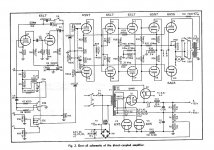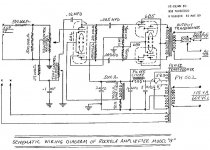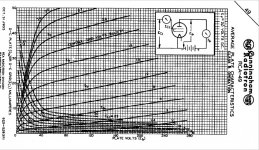Are there any? Also, no triode connected pentodes or tetrodes please😉 I have some 843s which are low power and high plate resistance so I have yet to figure out a use for them. Thanks🙂
Do you mean like the 6080/6AS7 type? The 5998 and 6528 can be nice. Don’t forget the soviet classics like the 6C33 and 6C19.
6A5G
IDH attached internally to the cathode tho. It was used in one of the amps published in Audio Magazine about 60 yrs ago.
IDH attached internally to the cathode tho. It was used in one of the amps published in Audio Magazine about 60 yrs ago.
Attachments
Last edited:
Many of the small triodes meant as vertical Oscillators are the basis of quite a few very good amplifiers up to 5-6 watts. Worth a look.
6EA7/6EM7, 6CK4, 6BL7, 6BX7 on & on.🙂
6EA7/6EM7, 6CK4, 6BL7, 6BX7 on & on.🙂
Last edited:
The 843 is best used as a Class AB2 RF amplifier, or a Class C RF oscillator.
Typical operation of both, requires very high plate load impedance (Hi Q Resonant plate load), and typically will use up to 7.5mA of grid current (DC value, not even the peak RF current value).
The high impedance comes from High Q L and High Q C, of the resonant tank (usually a Pi network, or an air wound transformer, no laminations.
That is all good and well for an RF tube of that design.
Try and design an audio output transformer of very high impedance from 20Hz to 20,000Hz. You can not resonate it like you can an RF output circuit to easily get the impedance you need.
And, to get the power from the tube, you not only need the high Z Rp, you need to drive the tube into Class A2 for single ended, and Class AB2 for push pull.
Otherwise, the output power will be less than what the same tube can do for RF.
15 Watt plate dissipation is high power for some, and low power for others. It is all in the eye of the beholder.
If someone has curves for an 843, you could see what kind of load impedance that it requires for a reasonable Class A output circuit.
Just my opinion.
Typical operation of both, requires very high plate load impedance (Hi Q Resonant plate load), and typically will use up to 7.5mA of grid current (DC value, not even the peak RF current value).
The high impedance comes from High Q L and High Q C, of the resonant tank (usually a Pi network, or an air wound transformer, no laminations.
That is all good and well for an RF tube of that design.
Try and design an audio output transformer of very high impedance from 20Hz to 20,000Hz. You can not resonate it like you can an RF output circuit to easily get the impedance you need.
And, to get the power from the tube, you not only need the high Z Rp, you need to drive the tube into Class A2 for single ended, and Class AB2 for push pull.
Otherwise, the output power will be less than what the same tube can do for RF.
15 Watt plate dissipation is high power for some, and low power for others. It is all in the eye of the beholder.
If someone has curves for an 843, you could see what kind of load impedance that it requires for a reasonable Class A output circuit.
Just my opinion.
Last edited:
Take a look at the thread "JC Morrison 300B", Post # 30.
You can see the simulation of AC filaments on a DHT.
Look at the simulation, see the results, and consider the cause of the results (different Delta transconductance, just as it occurs along the length of a real DHT).
Done?
Done.
Ooops, wrong thread, does not apply to this thread, sorry.
You can see the simulation of AC filaments on a DHT.
Look at the simulation, see the results, and consider the cause of the results (different Delta transconductance, just as it occurs along the length of a real DHT).
Done?
Done.
Ooops, wrong thread, does not apply to this thread, sorry.
Last edited:
I'm not clear of what kind of power triode you seek.Are there any? Also, no triode connected pentodes or tetrodes please😉 I have some 843s which are low power and high plate resistance so I have yet to figure out a use for them. Thanks🙂
ECC99 can give ~4w in pushpull
Greatly appreciated!
I was thinking more in terms of SE, not PP🙂 ECC99 might work in parallel
OTOH I have several 6BX7 and there is a schematic for that tube on the Electraprint website which I may try😎
BTW why do I get a Forbidden when I click on your link?
I was thinking more in terms of SE, not PP🙂 ECC99 might work in parallel

OTOH I have several 6BX7 and there is a schematic for that tube on the Electraprint website which I may try😎
BTW why do I get a Forbidden when I click on your link?
Last edited:
I'm not familiar with the 843 so I checked the data sheet. It lists two operating points with power output as .95w and 1.6w. I assume you're looking for more than that.Are there any? Also, no triode connected pentodes or tetrodes please😉 I have some 843s which are low power and high plate resistance so I have yet to figure out a use for them. Thanks🙂
I've used the 6A5G, which was suggested above. It's essentially an indirectly heated 2A3 with a 6.3v heater. Actually more like an indirectly heated 6B4G, I suppose, since it has an octal base. Power output is 3.75w.
The tube I'm into lately is the 6N6G. The 6N6G is an octal version of the 6B5, which was developed in 1935. Here's an extremely detailed writeup on the technical aspects. Most of this makes my head spin, but you might find it interesting.
http://tubedata.milbert.com/sheets/201/6/6B5.pdf
https://tube-data.com/sheets/201/6/6N6MG.pdf
It's a dual, dissimilar, triode. The input triode is configured as a cathode follower and is directly connected to the output triode. All the biasing is done internally, so the cathode pin connects directly to ground.
It's very easy to drive. I modded an old Magnavox PP 6V6 amp to use them and I've got a SE amp breadboarded. I'm using a 26 on the input but I've also tried numerous other DHT inputs with excellent results (864, 01A, 30, 12A). Maximum power output is 5.2w SE and 13.5w PP.
It's the equivalent of a 76 directly coupled to a 6AC5 but in a single bottle. Having it in a single tube with the coupling already done is certainly more convenient but if you want to use it differently, just use the 6AC5.
https://tube-data.com/sheets/201/6/6AC5G.pdf
https://tube-data.com/sheets/127/6/6AC5GT.pdf
Last edited:
Intriguing
Well, I have looked at the data sheets😕 and I am having a hard time wrapping my head around this. If I understand correctly, for the 6b5 or 6n6 you simply ground the cathode and provide the appropriate power and input signal and it works😱?
The other thing I find confusing is that the plate resistance is ~24k and yet the load is specified as 7k. How does this work? Thanks for the info🙂
Well, I have looked at the data sheets😕 and I am having a hard time wrapping my head around this. If I understand correctly, for the 6b5 or 6n6 you simply ground the cathode and provide the appropriate power and input signal and it works😱?
The other thing I find confusing is that the plate resistance is ~24k and yet the load is specified as 7k. How does this work? Thanks for the info🙂
Bottom line is it simulates a pentode. I've formed something similar with a 6F6, G1 & G2 driven by a paralled 6SN7. All covered somewhere here on DIY..🙂
I was thinking more in terms of SE, not PP🙂 ECC99 might work in parallel
OTOH I have several 6BX7 and there is a schematic for that tube on the Electraprint website which I may try😎
BTW why do I get a Forbidden when I click on your link?
6EA7/6EM7, dissimilar dual triode, one section drives, the other is power. Or 6LU8, triode/pentode. Triode as the driver, pentode in SE or SEUL, I've done both with good results. Both published in Glass Audio about 20 yrs ago.🙂
6BX7 or 6BL7 in PP, about 3W in Class A. Done those a few years ago, results all here somewhere on DIY. Or search 'Betty Crocker Special'. The experimental cct was built in an inverted cake tin.😱
Exactly. Super simple. Here's the thread on my PP 6N6G that I built on a Magnavox 185 chassis using the stock transformers.Well, I have looked at the data sheets😕 and I am having a hard time wrapping my head around this. If I understand correctly, for the 6b5 or 6n6 you simply ground the cathode and provide the appropriate power and input signal and it works😱?
Magnavox 175/185 Build . . . With a Twist | Audiokarma Home Audio Stereo Discussion Forums
I don't know about the plate resistance. Is it the output triode listed in the data sheet or a combination of input and output? I noticed that plate resistance is different from the 6AC5.The other thing I find confusing is that the plate resistance is ~24k and yet the load is specified as 7k. How does this work? Thanks for the info🙂
As for the load, I'm not using OTs that provide the optimal load. The SET version I've got breadboarded uses OTs from a Voice of Music SE 6BQ5 console amp which measure ~8.85k into 8 ohms. I usually build with junkbox parts (my PT was pulled from a disfunctional Webcor tape recorder) but I may order some Edcor 7k OTs for this one.
I do know that it's a great sounding tube that's simple to implement, easy to drive and it has a very useable power output. I'm really liking it with the various DHT input tubes.
I don't know about the plate resistance. Is it the output triode listed in the data sheet or a combination of input and output? I noticed that plate resistance is different from the 6AC5.
The output triode determines the plate resistance of the resulting composite tube. It is high like a pentode, it starts out essentially as a zero bias, high mu triode. There are some plate curves on a bare bones 46, page 3 shewing such curves. A rather low mu triode is required for the driver, it needs to pull grid current thru the output section grids in order to get it into a linear operating range.
The input plate can be used just as we would a screen grid, thus UL operation is possible. If we go as far as connecting the input plate to the output plate it does the same as connecting G2 of a pentode to its plate.🙂
The DF is much like a pentode without NFB. So if rp is 30K & Rl is 7K, the DF is ~7/30, not including the OPT. The only real advantage these tubes have, they are self biasing.
Many ordinary power pentodes can be operated this way. For the tests I did using a 6F6 I measured the mu in this mode to be ~50.
Some of Charlies set of spec sheets are good info, I hadn't seen those before. But quite a bit sounds like a sales pitch, something I'm very familiar with. But given the stuff I was flogging, I would do it all again.🙂
The output triode determines the plate resistance of the resulting composite tube. It is high like a pentode, it starts out essentially as a zero bias, high mu triode. There are some plate curves on a bare bones 46, page 3 shewing such curves. A rather low mu triode is required for the driver, it needs to pull grid current thru the output section grids in order to get it into a linear operating range.
The input plate can be used just as we would a screen grid, thus UL operation is possible. If we go as far as connecting the input plate to the output plate it does the same as connecting G2 of a pentode to its plate.🙂
The DF is much like a pentode without NFB. So if rp is 30K & Rl is 7K, the DF is ~7/30, not including the OPT. The only real advantage these tubes have, they are self biasing.
Many ordinary power pentodes can be operated this way. For the tests I did using a 6F6 I measured the mu in this mode to be ~50.
Some of Charlies set of spec sheets are good info, I hadn't seen those before. But quite a bit sounds like a sales pitch, something I'm very familiar with. But given the stuff I was flogging, I would do it all again.🙂
Attachments
This example lifted from the pages of Audio Engineering magazine, April 1951.🙂
The author appears to be paid by the number of times.
I have a few of those Rockola amps I Abought 20 years ago to give them a quick try with my A-7’a.
Still haven’t gotten to them, like most of my planned projects.
I got a bunch of NOS 843’s about the same time. Still haven’t gotten to them yet.
They were worth so little that the guy I got them from used them as packing material for pair of NOS GE VT-4C’s (211’s), LoL I bought from him.
I’m told that the 843 is similar in sound to a 45. I sure hope I get to verify that soon. I’ve had two negative Covid tests in the past two weeks, but you never know.
Here today, gone tomorrow.
Peace,
Technical
Still haven’t gotten to them, like most of my planned projects.
I got a bunch of NOS 843’s about the same time. Still haven’t gotten to them yet.
They were worth so little that the guy I got them from used them as packing material for pair of NOS GE VT-4C’s (211’s), LoL I bought from him.
I’m told that the 843 is similar in sound to a 45. I sure hope I get to verify that soon. I’ve had two negative Covid tests in the past two weeks, but you never know.
Here today, gone tomorrow.
Peace,
Technical
- Home
- Amplifiers
- Tubes / Valves
- Indirectly heated power triodes


